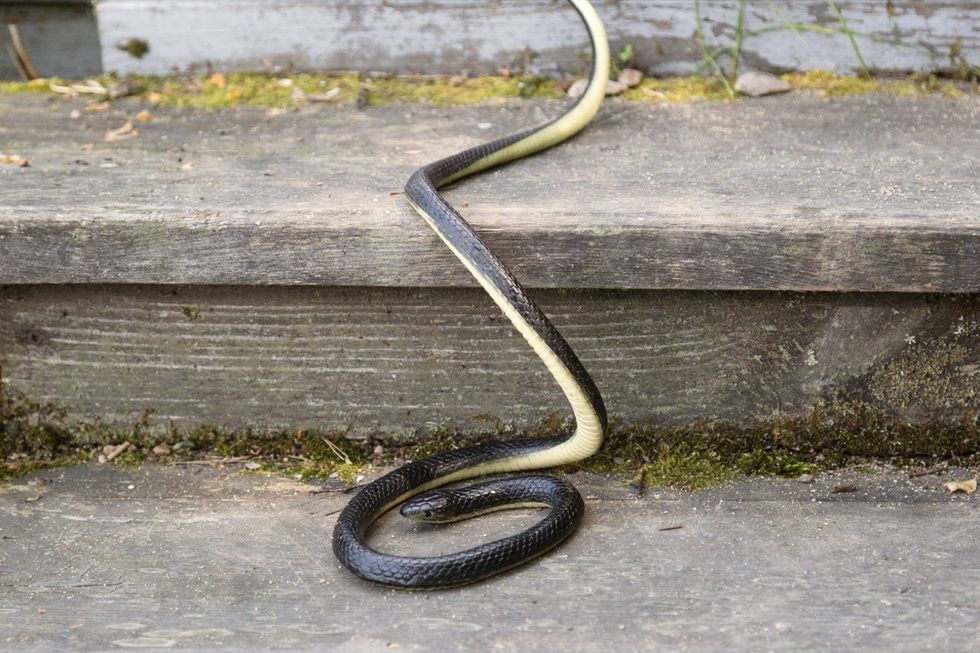Like humans, animals prefer to shut out the cold by cozying up indoors during the frigid winter months. Many mammals choose to hibernate, retreating to their dens, caves, nests, and underground tunnels until springtime. This probably sounds like a good thing, right? Well, not exactly. Contrary to popular belief, snakes are active (to a degree) year-round. In fact, these scaly creatures are arguably just as likely to infiltrate your home when it’s cold outside, according to animal control experts.
RELATED: 6 Top Signs There Are Snakes in Your Yard.
Although snake sightings are most common in warmer weather, that doesn’t mean they won’t come to play in cooler temperatures. During the winter, when temperatures drop, snakes enter a state known as brumation, Nick Durieu from Senate Termite & Pest Control previously told Best Life. “But although it’s similar to hibernation, snakes don’t sleep throughout the entire season.”
Depending on where you live, the brumation period “generally begins between September and December and can last until March or April,” per Durieu. If winter temperatures remain mild, which they have in recent years, snakes may brave the weather to explore and rummage for food.
“Snakes can actually wake up and forage for food or water, especially if temperatures rise, even for just a few days,” Durieu added. This includes taking shelter in otherwise occupied areas, like your home.
Arizona residents are experiencing this firsthand following an increase in rattlesnake home sightings. Speaking with local CBS affiliate 13 News this month, Arizona Animal Experts co-owner Jeff Carver said the area’s shifting temperatures have prompted snakes to look elsewhere for warmth, including in and around homes.
“When the weather shifts like this, a lot of, a lot of times people are like, oh, well, how cold does it have to be until I don’t have to worry about snakes?” Carver told the news station, adding: “We don’t ever get that cold.”
When temperatures do dip, snakes will look for “a nice little hiding spot” like gardening pots or sheds to keep warm, bringing them closer to your home.
RELATED: 7 Best Tips to Rodent-Proof Your House for Fall.
Snakes that are extra daring will try to break into your garage, too, warned Carver. This can pose a terrifying—and potentially harmful—threat to homeowners who use their garages for storage.
“I often tell people that one of our busier days of the season is the day after Thanksgiving because that’s when, historically, a lot of us will go into the garage, start pulling out Christmas decorations and things like that,” Carver said.
Meanwhile, a local newspaper agency in South Carolina is warning its residents to stay on the lookout for potential copperhead sightings this winter. The venomous snake has a large population in the Palmetto State and is most active during the daytime through the month of November, per The State.
To protect your home, animal experts suggest limiting leaf piles, maintaining manicured grass and shrubbery, and caulking gaps in your home’s foundation. If you keep a pile of firewood, store it far away from the house and garage. Additionally, try to avoid any rock landscaping that could double as a hiding place.
“If you need a wood or rock pile, keep it far from your house so animals won’t be tempted to sneak into your home while they are hiding out,” Nancy Troyano, PhD, a board-certified entomologist with Ehrlich Pest Control, previously told Best Life.
“Be cautious reaching into those piles,” she cautions. “You never know what you’ll stumble upon.”
Keeping your garage well-ventilated will help keep snakes away, as will emptying bird baths or other places with standing water. Setting up mice traps is another way to keep out squeaky and slithering creatures.

